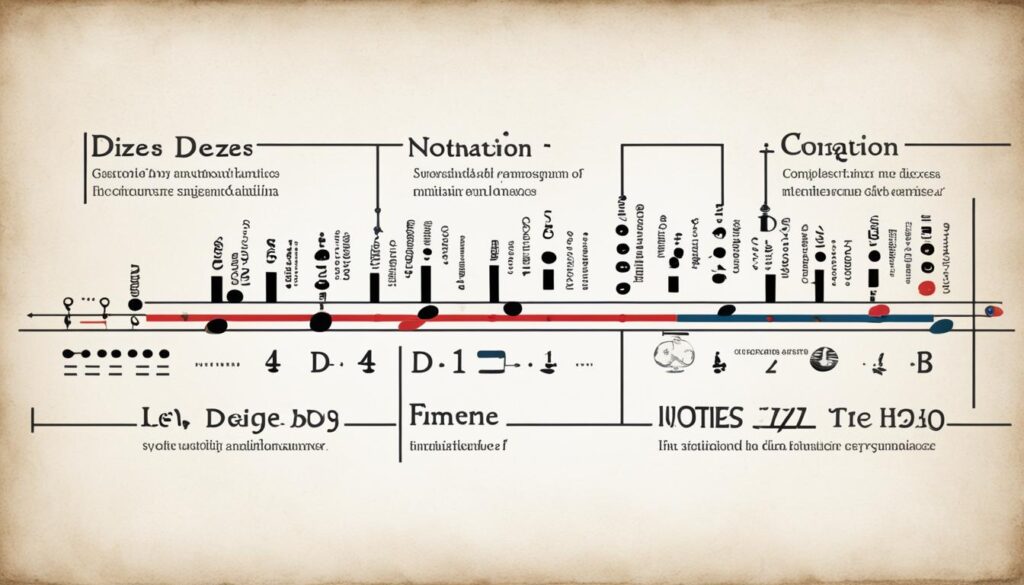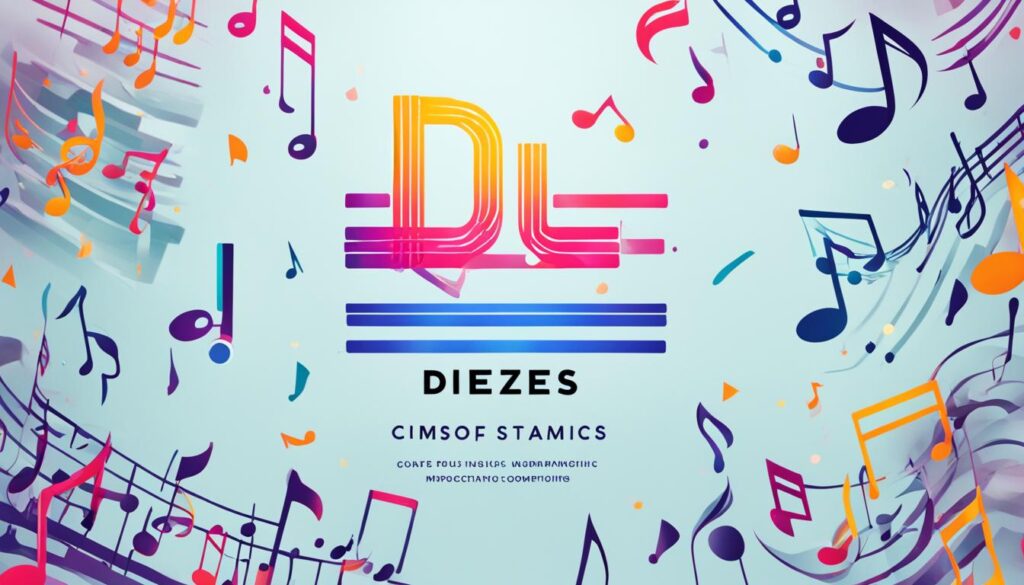Step into the amazing world of diezes, a key part of music that adds life to melodies. They change musical pitches. This makes sheet music easier to read, helping musicians play songs just right. It’s all about making sounds clearer and helping performers understand scores.
Diezes are important in music because they raise notes by a semitone. This small change lets composers create the sound they want. Plus, using diezes well makes sheet music easy to read. This helps musicians play with confidence and precision.
Key Takeaways
- Diezes are vital for altering musical pitches, enhancing the dynamism of compositions.
- They play a pivotal role in music notation, making complex musical scores accessible and interpretable.
- Proper use of diezes contributes significantly to sheet music clarity, aiding in flawless musical performances.
- Understanding diezes is essential for musicians to accurately execute a composer’s intentions.
- The strategic placement of diezes within sheet music is key to maintaining an unambiguous musical dialogue between the score and the performer.
The Fundamentals of Diezes in Music Notation
Diezes change pitches in music, playing a key role. They help make music diverse and exact. Along with sharps and flats, diezes accurately adjust notes on the staff. They make musical compositions clear and organized.
Understanding the Role of Diezes in Altering Musical Pitches
Diezes do more than change a note’s look; they’re crucial for music. By increasing a note’s pitch by half a tone, they alter pitches. This change is vital for harmonics, offering sound variations for composers and musicians.
Diezes Versus Flats: Navigating Sharps and Flats on the Staff
Diezes raise notes, while flats lower them. Understanding sharps and flats on the staff is about knowing their effects. These signs help musicians play music correctly and precisely.
Visualizing Diezes on the Fretboard: A Guide for Guitarists
For guitar players, seeing diezes on the fretboard might be hard at first. But with clear markings, they can get the hang of it. Learning to use diezes can improve their music and creativity.
Historical Evolution of Diezes and their Notation
The historical evolution of diezes and their notation is a captivating story in music history. At first, found in medieval scripts, diezes changed a lot in how they’re shown and used. This change tells us a lot about the move to today’s music symbols.
Learning about old ways of marking diezes helps us see how complex today’s music writing is. The move from simple signs to today’s detailed systems shows how music writing and playing have evolved. It highlights the lively nature of sharing music.

Diezes started playing bigger roles in music, more than just changing notes. They became key in shaping the harmony of songs in many styles. This wasn’t just a change in technique but also in culture. It shows how music tastes and writing styles have changed over time.
Once viewed as simple pitch modifiers, diezes now embody complex relationships in musical keys and harmony, marking their indelible impact on the craft of music-making.
In conclusion, diezes’ journey from simple signs to essential musical theory parts shows their importance. They help create the rich melodies that mark both past and present music.
Diezes in Modern Music Composition: A Creative Tool
Diezes are now essential in modern music, helping create new sounds and boost musical creativity. They’re used in various music genres and electronic music, giving rise to new innovations. This makes them a key tool for musicians and composers.
Innovative Use of Diezes in Contemporary Musical Genres
In contemporary music, diezes go beyond being just functional. They spark creativity. Composers use them to change melodies and harmonies, creating unique music. This is especially true in genres that value complex sounds and new harmonic patterns.
Diezes in Electronic Music Production: Pushing Boundaries
In electronic music, diezes have a big impact. They let producers modify traditional sounds and expand electronic music’s possibilities. By using software and synthesizers, producers use diezes to create new sounds. These tones fit well with the digital era, making music that’s both modern and groundbreaking.

Diezes are crucial in making electronic music stand out. They blend old musical ideas with new technology, creating sounds unique to this genre. This shows how traditional music elements like diezes can find new life in today’s digital world.
| Genre | Role of Diezes | Technological Integration |
|---|---|---|
| Contemporary Jazz | Harmonic Complexity | Minimal |
| Electronic Dance Music | Tonal Experimentation | High |
| Experimental Pop | Melodic Innovation | Moderate |
In short, diezes have gone from simple notation elements to powerful creative tools in music. They enable unique musical expressions in many genres, especially in electronic music production. With the help of technology and creativity, diezes keep pushing music into new territories.
Visual Symbols in Music: More Than Just Notes and Rhythms
In the world of music, visual symbols are crucial. They go well beyond just notes and rhythms. These symbols guide musicians, offering cues on pitch, tempo, and dynamics.
Visual symbols in music are not just for notation; they’re the heart of musical storytelling. They make written music a vibrant experience that goes beyond cultures and ages.
Some symbols in music are known worldwide. For instance, a sharp or a flat changes a note’s pitch. This tweak can alter the mood and meaning of music, enhancing how composers and musicians connect.
The way symbols are arranged makes a big difference too. This setup can change how a musician understands and plays a piece. It guides their focus, timing, and style, shaping the music’s overall sound.

Delving into visual symbols shows us their value in music. They’re more than just guides. These symbols express emotions and complex ideas, enriching our listening experience.
Thus, visual symbols in music are key not only in making music but also in how we enjoy it. They go beyond notes and beats, reaching the heart of what music means.
Diezes and Music Theory: Building a Solid Foundation
Diezes and music theory together form the base for understanding key signatures. Knowing diezes well makes reading and playing music smoother. It helps musicians tackle complex pieces with ease.
Diezes and Key Signatures: The Connection Explained
Diezes are key to key signatures that set a music piece’s scale. Musicians need to know this to play or compose in different keys. Key signatures with diezes change note pitches, affecting the music’s sound.
Practical Exercises to Master the Use of Diezes in Scales
Practical exercises help musicians master diezes in scales. These exercises convert theory into hands-on skills. It’s about making diezes part of daily music play and writing.
| Scale | Key Signature with Diezes | Exercise Type |
|---|---|---|
| G Major | F# | Scale Ascending and Descending |
| D Major | F#, C# | Intervals Practice |
| A Major | F#, C#, G# | Chord Construction |
| E Major | F#, C#, G#, D# | Improvisation Over Backing Track |
| B Major | F#, C#, G#, D#, A# | Composition Exercise |
The table shows exercises for key signatures with diezes. It’s aimed at boosting scale knowledge for musicians. Practicing these scales helps improve music theory skills and playing fluidity.
Diezes as Pitch Indicators in Vocal Performances
In vocal performances, diezes are key. They help singers follow melodies with precision. This leads to performances that are both precise and full of feeling. Knowing how diezes work in music helps singers stay true to the composition.
Diezes change how notes sound, guiding singers to adjust their pitch. This is crucial in styles where pitch must be exact. Thanks to diezes, vocalists can enhance their performance, adding depth and richness.
Diezes enable singers to execute pitches that resonate with the intended emotional and musical expressions of the composition.
Let’s see how diezes affect singing in different music types:
- Classical Music: Diezes are needed for accurately performing complex pieces. They help in navigating shifting harmonies.
- Jazz: They support improvisation, letting singers experiment while staying coherent musically.
- Pop Music: Diezes assist in fine-tuning pitches for catchy parts that connect with many listeners.
| Genre | Role of Diezes | Impact on Performance |
|---|---|---|
| Classical | Crucial for accuracy | Enhances emotional depth |
| Jazz | Facilitates improvisation | Enables creative freedom |
| Pop | Essential for hooks | Increase in commercial appeal |

Enhancing Sheet Music Legibility: The Strategic Placement of Diezes
Improving sheet music is key, and using diezes right is part of it. These sharps change note pitches in music. Their placement helps musicians read and play more easily, especially in tough pieces.
When placing diezes, think about the music’s key, how crowded the page looks, and how easy it is to read. Good placement stops confusion and makes playing smoother. This way, the music stays true to its original sound.
Composers can use software to help place diezes well. Or, they can manually fix spacing in crowded parts. The goal is to make the sheet music clear and more visually appealing. This helps musicians perform their best.



